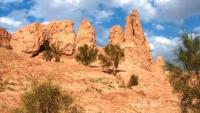You are here
Shasenem ancient settlement.

Ancient monuments to Dashoguz region.
Ancient sights of Dashoguz region.
In the vicinities of Dashoguz and the cities of the Dashoguz region sands of Kara-Kum store traces of former brisk life on caravan roads and in the oases which were once supplied with water from the Amu Darya River which subsequently changed the direction of the course.
Is situated close to the ancient canal Chermenyab, at the end of the medieval irrigated lands, about 90 km to the northwest of Dashoguz. These are the ruins of a medieval town Suburny, which is mentioned by the great traveler Yakut who visited it before Mongol encroachment. The town represents irregular in plan hill rising up to 9 meters.
The preserved outer walls of the hill reach 15 m. To the north-west of Shasenem there was a parking complex with pavilions and central buildings constructed at the last period of existence of town (XII - XIII). To this period belong numerous ruins of mansions, irrigation network, as well as big complex of workshops for making glass and glass products situated in the northeast and east of the town.
According to archeologists, in IV c B/C-III A/D here existed a fortress. The flourishment of town dates back to the period of Khoresm shahs reign (XI - beginning of VIII). After Mongol invasion of the fortress underwent some restoration work but was invaded by the army of Timur.
Archeological excavations revealed here ruins of a big mosque (XII - XIII) richly decorated by cut alabaster. Big artistic value possesses the discovered mihrab(altar niche) with its tracery alabaster semi columns decorated by various ornaments and Arabic inscriptions.
Among artifacts found from the site there is a well-preserved bronze pot covered by inscriptions and ornaments. From the big and small cities existing in the Middle Ages ancient settlements from the remains of the defensive walls, separate constructions most often built from a brick raw and a pakhsa nowadays remained.
On the roads connecting Khorezm with Margiana and Kharasan, the cities were transit points of transit trade. Numerous ancient settlements and certain buildings are still insufficiently studied. In the southern part of the Dashoguz region such large ancient settlements as Zmukshir, Shasenem, Yar-bekir and others are located.
To the northwest of Kunya-Urgench, in a zone of influence of old Amu Darya Canal, Shirvan-kala, Chardary-kala and at the corner of the high steep stone plateau - the grandiose ancient settlement Dehkesken-kala.
Except ancient settlements, ruins of separate constructions - mausoleums, madrasah and inhabited estates of different time meet. If the fortress remains Yar-bekir with the remained fragments of towers and walls give only a general idea about contours and character of the medieval settlement.
Then the most southern ancient settlement Shasenem, magnificent on power of architectural impression, testifies to the intensive life of the city and accident as a result of the Mongolian disorder which comprehended it during blossoming in the XIIIth century.
This fortress as showed preliminary excavation of 1952, arose during the antique period, existed at the time of the Kushan kingdom at the beginning of our era and was revived by horezmshakha as the most southern point (about 100 km. from Kunya-Urgench) on the caravan road to Kharasan.
owadays the ancient settlement consists of two independent parts. The first of them - actually the city - the fortress which is highly located on an artificial platform with defensive ditches and walls, towers, with a perverse labyrinth and ruins of structures inside.
On the remains of adobe two-row walls arrow-shaped loopholes remained. In 200 meters to the southwest of fortress, at its bottom, the rectangular ancient settlement (375 x 345 m) which is conditionally called by gardens of Shasenem was out of the blue stretched.
Here, apparently, there were kitchen gardens and gardens surrounded with a blank wall with pro-pileas and G-shaped pavilions on site corners. On an entrance axis, in depth ruins of the lock of the governor remained (can be, his country residence).
The present name of Shasenem-kala was received by ruins of the medieval city of Suburn (in translation - the cape or the edge of water). It was the last settlement on the southern border of the Khorezm oasis.
Authority:
On materials of information department of the State committee of Turkmenistan on tourism and sport. "Religious and spiritual monuments to Central Asia". Author M. Hashimov. Saga publishing house, 2001
Photos
Alexander Petrov.







